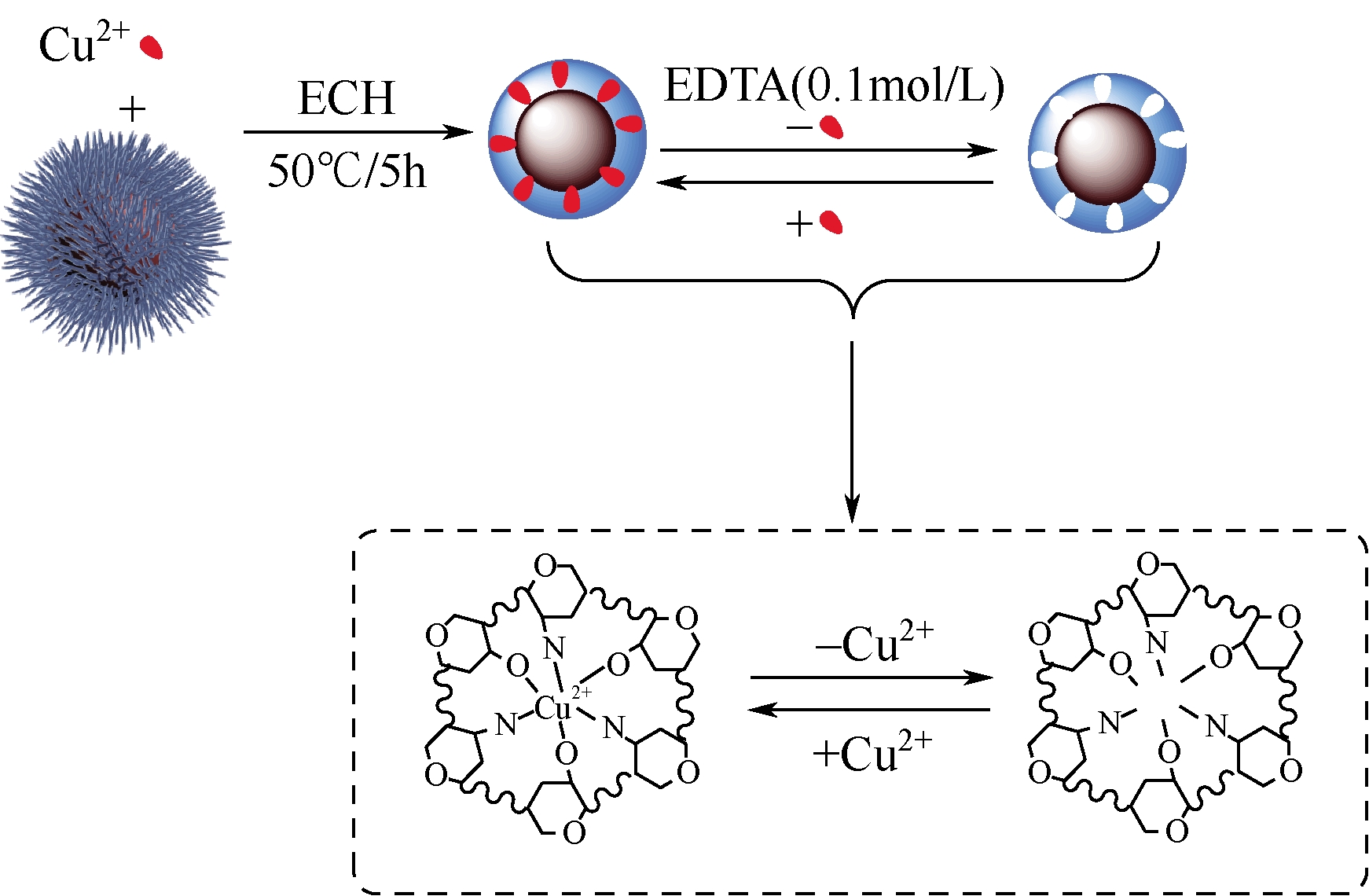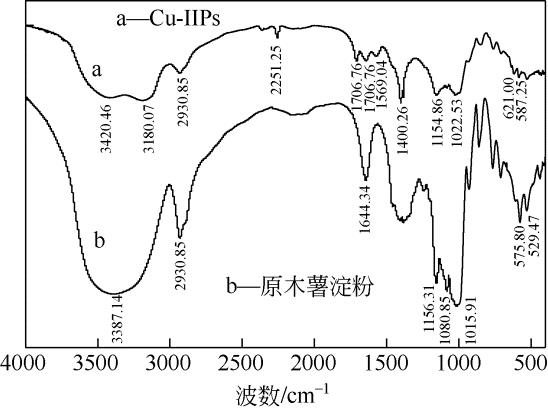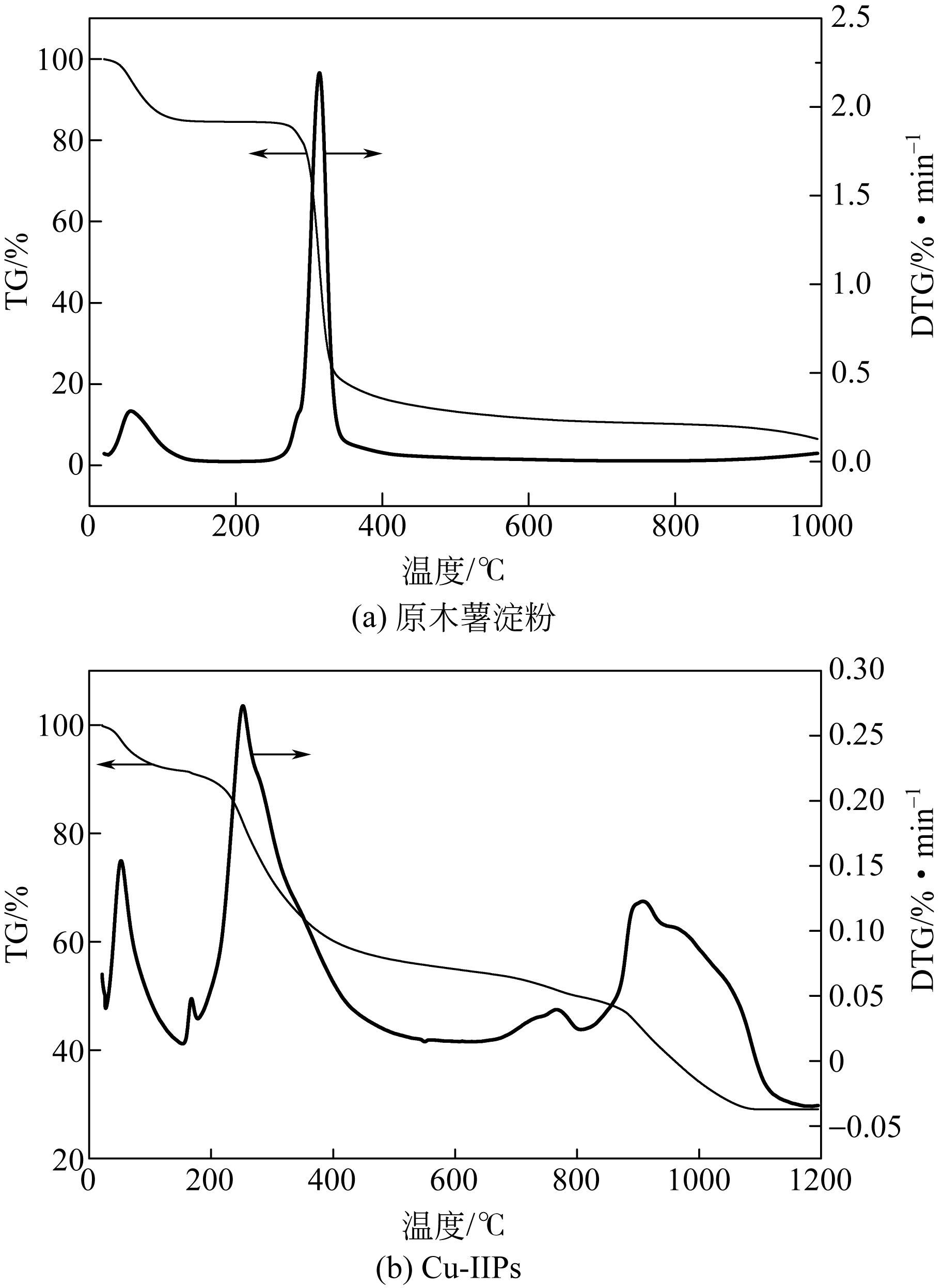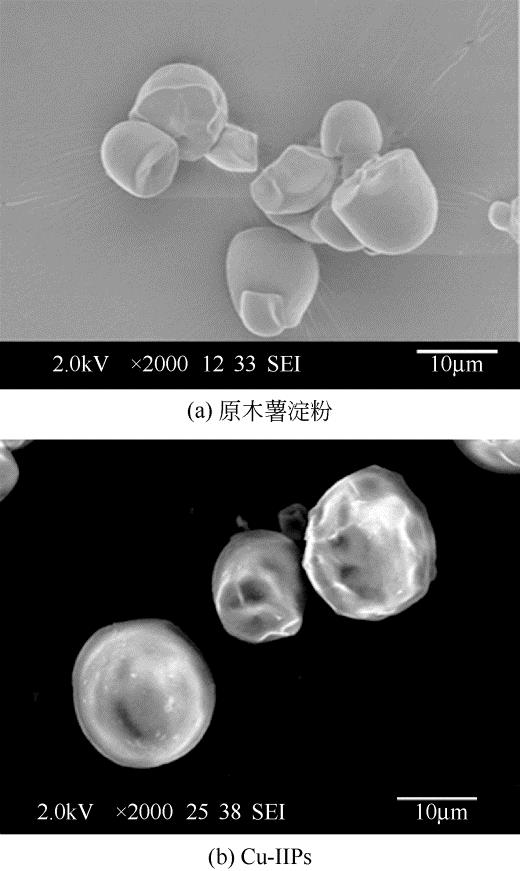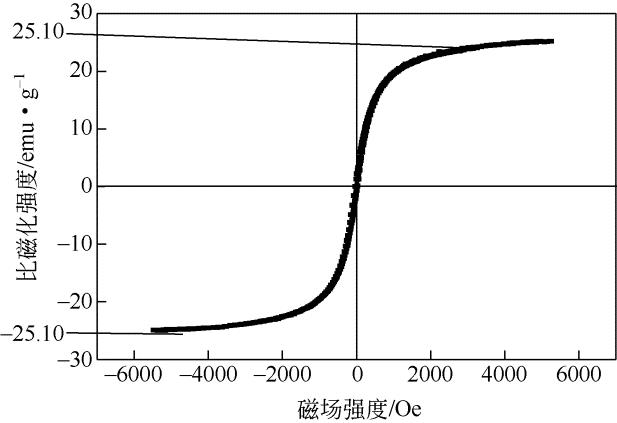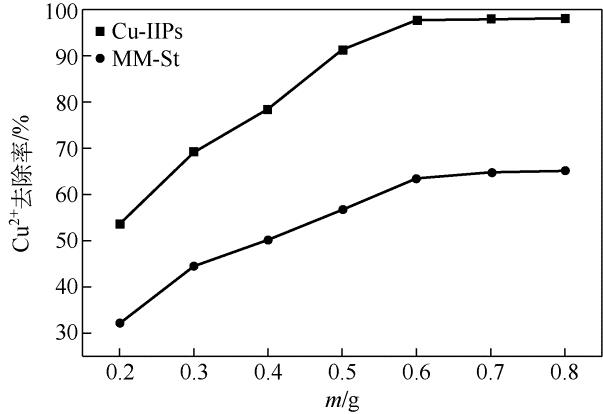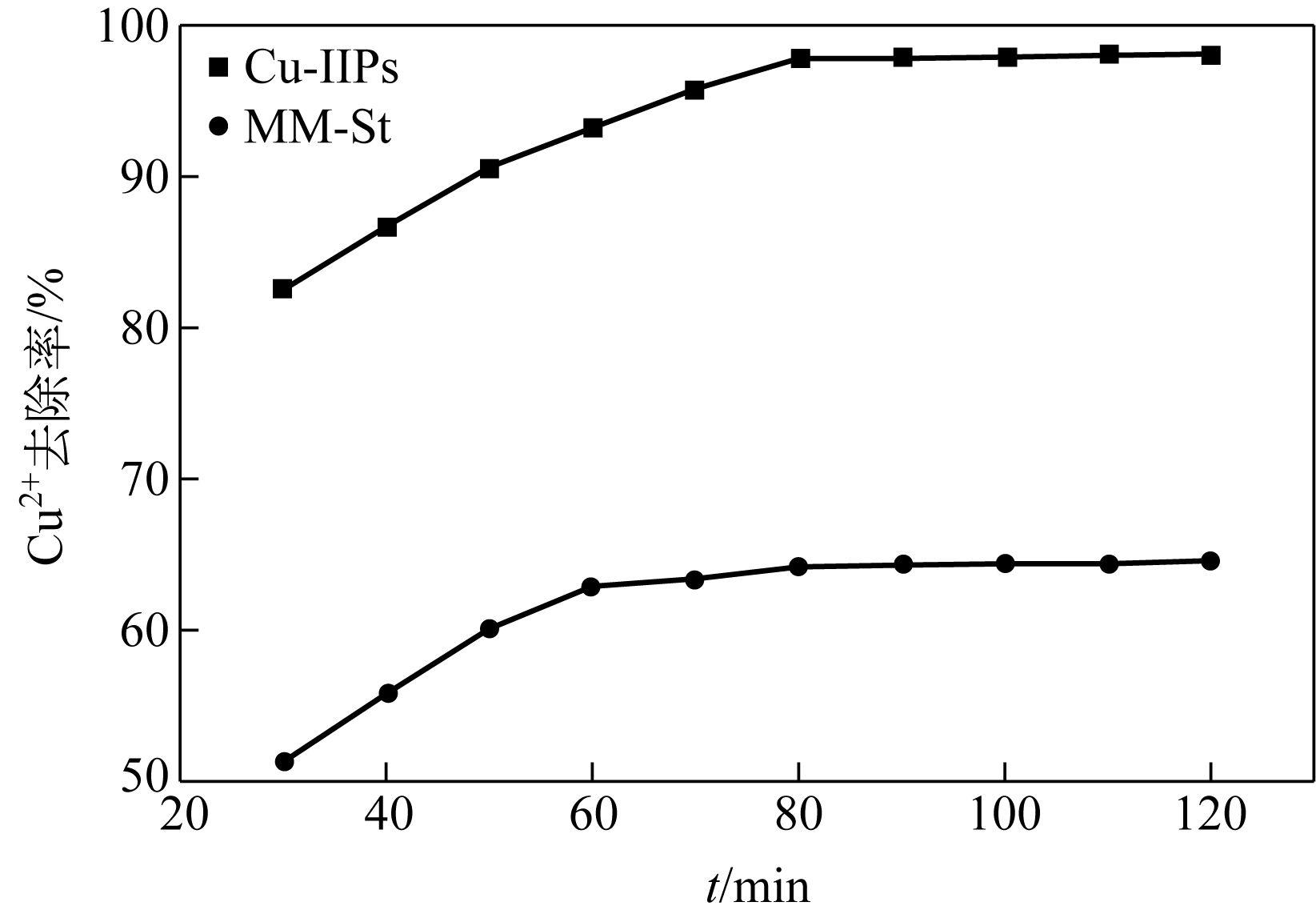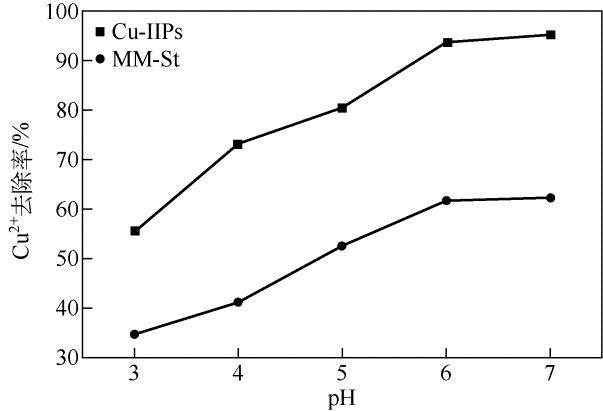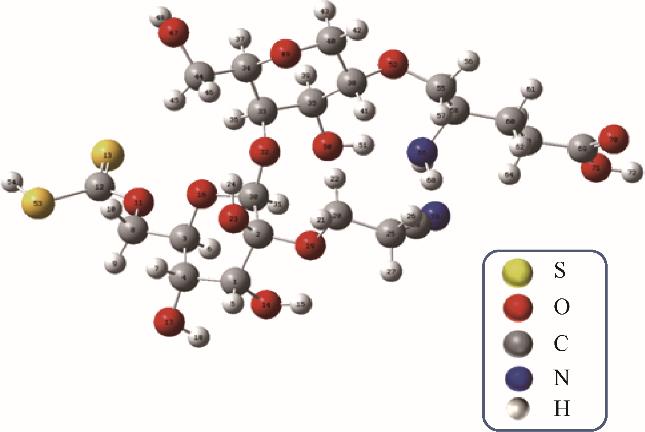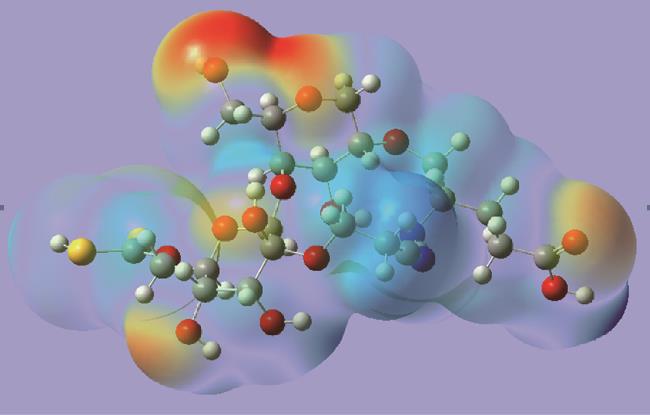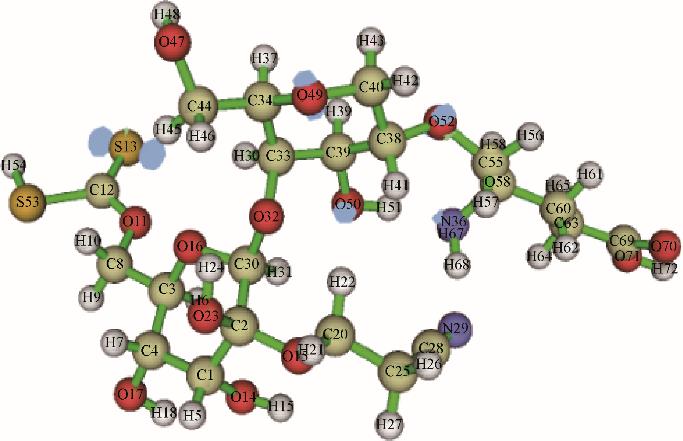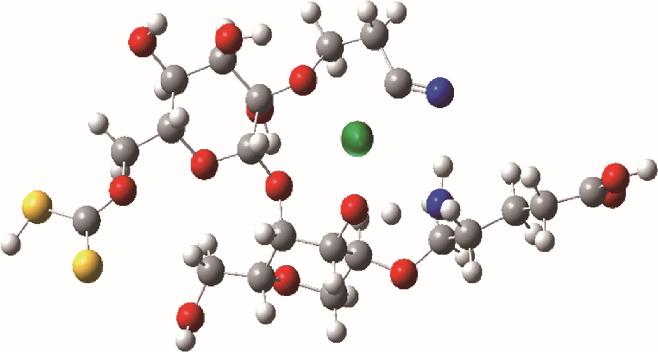Chemical Industry and Engineering Progress ›› 2019, Vol. 38 ›› Issue (04): 1930-1940.DOI: 10.16085/j.issn.1000-6613.2018-1272
• Fine chemicals • Previous Articles Next Articles
Synthesis and adsorpting property of magnetic imprinted crosslinked acrylic acid/acrylamide grafted-esterified cyanoethyl cassava starch microspheres
Heping LI1( ),Jun GONG1,2,Shufen ZHANG1,2,Jun ZHANG1,Yingxiang HU1
),Jun GONG1,2,Shufen ZHANG1,2,Jun ZHANG1,Yingxiang HU1
- 1. College of Chemistry and Biology Engineering,Guilin University of Technology,Guilin 541004,Guangxi,China
2. State Key Laboratory of Fine Chemicals,Dalian University of Technology,Dalian 116204,Liaoning,China
-
Received:2018-06-20Revised:2018-09-10Online:2019-04-05Published:2019-04-05
磁性印迹交联AA/AM接枝酯化氰乙基木薯淀粉微球的制备与吸附性能
- 1. 桂林理工大学化学与生物工程学院,广西 桂林 541004
2. 大连理工大学精细化工国家重点实验室,辽宁 大连 116024
-
作者简介:李和平(1961—),男,教授,工学博士,主要从事绿色精细有机合成研究。E-mail:<email>lhpp2008@163.com</email>。 -
基金资助:国家自然科学基金(21466010);桂林市科学研究与技术开发计划(20150105-5)
CLC Number:
Cite this article
Heping LI, Jun GONG, Shufen ZHANG, Jun ZHANG, Yingxiang HU. Synthesis and adsorpting property of magnetic imprinted crosslinked acrylic acid/acrylamide grafted-esterified cyanoethyl cassava starch microspheres[J]. Chemical Industry and Engineering Progress, 2019, 38(04): 1930-1940.
李和平, 龚俊, 张淑芬, 张俊, 胡英相. 磁性印迹交联AA/AM接枝酯化氰乙基木薯淀粉微球的制备与吸附性能[J]. 化工进展, 2019, 38(04): 1930-1940.
share this article
Add to citation manager EndNote|Ris|BibTeX
URL: https://hgjz.cip.com.cn/EN/10.16085/j.issn.1000-6613.2018-1272
| 再生次数 | Q/mg?g-1 | 再生次数 | Q/mg?g-1 |
|---|---|---|---|
| 0 | 25.96 | 3 | 22.68 |
| 1 | 24.21 | 4 | 21.12 |
| 2 | 23.07 |
| 再生次数 | Q/mg?g-1 | 再生次数 | Q/mg?g-1 |
|---|---|---|---|
| 0 | 25.96 | 3 | 22.68 |
| 1 | 24.21 | 4 | 21.12 |
| 2 | 23.07 |
| 配合物 | E HOMO /eV | E LUMO /eV | /eV | μ /Debye | χ /eV | η /eV | |
|---|---|---|---|---|---|---|---|
| Cu-IIPs | -0.231 | -0.062 | 0.169 | 5.172 | 0.147 | 0.0845 | 0.3006 |
| 配合物 | E HOMO /eV | E LUMO /eV | /eV | μ /Debye | χ /eV | η /eV | |
|---|---|---|---|---|---|---|---|
| Cu-IIPs | -0.231 | -0.062 | 0.169 | 5.172 | 0.147 | 0.0845 | 0.3006 |
| 原子 | f + | f - | 原子 | f + | f - | 原子 | f + | f - |
|---|---|---|---|---|---|---|---|---|
| C1 | –0.0012 | 0.0021 | O23 | 0.0168 | 0.0082 | O49 | 0.0475 | 0.0059 |
| C2 | –0.0021 | –0.0032 | C25 | –0.0011 | 0.0033 | O50 | 0.0631 | –0.0054 |
| C3 | –0.0084 | 0.0004 | C28 | 0.0091 | 0.0336 | O52 | 0.0469 | 0.0032 |
| C4 | –0.0009 | –0.0030 | N29 | –0.0109 | 0.0088 | S53 | 0.0961 | 0.1394 |
| C8 | –0.0059 | –0.0254 | C30 | –0.0054 | –0.0032 | C55 | –0.0104 | 0.0054 |
| O11 | 0.0007 | 0.0381 | O32 | 0.0118 | 0.0070 | C58 | –0.0135 | –0.0064 |
| C12 | 0.0591 | 0.0875 | C33 | –0.0087 | 0.0033 | C60 | 0.0050 | –0.0022 |
| S13 | 0.1749 | 0.2235 | C34 | –0.0108 | 0.0024 | C63 | 0.0062 | –0.0092 |
| O14 | 0.0046 | –0.0013 | C35 | –0.0120 | –0.0025 | N66 | 0.0115 | –0.0020 |
| O16 | 0.0081 | –0.0052 | C38 | –0.0109 | –0.0004 | C69 | 0.0070 | 0.0771 |
| O17 | 0.0173 | 0.0032 | C40 | 0.0109 | 0.0032 | O70 | 0.0085 | 0.0672 |
| O19 | 0.0063 | –0.0002 | C44 | 0.0092 | 0.0032 | O71 | 0.0026 | 0.0300 |
| C20 | -0.0053 | -0.0050 | O47 | 0.0215 | 0.0117 |
| 原子 | f + | f - | 原子 | f + | f - | 原子 | f + | f - |
|---|---|---|---|---|---|---|---|---|
| C1 | –0.0012 | 0.0021 | O23 | 0.0168 | 0.0082 | O49 | 0.0475 | 0.0059 |
| C2 | –0.0021 | –0.0032 | C25 | –0.0011 | 0.0033 | O50 | 0.0631 | –0.0054 |
| C3 | –0.0084 | 0.0004 | C28 | 0.0091 | 0.0336 | O52 | 0.0469 | 0.0032 |
| C4 | –0.0009 | –0.0030 | N29 | –0.0109 | 0.0088 | S53 | 0.0961 | 0.1394 |
| C8 | –0.0059 | –0.0254 | C30 | –0.0054 | –0.0032 | C55 | –0.0104 | 0.0054 |
| O11 | 0.0007 | 0.0381 | O32 | 0.0118 | 0.0070 | C58 | –0.0135 | –0.0064 |
| C12 | 0.0591 | 0.0875 | C33 | –0.0087 | 0.0033 | C60 | 0.0050 | –0.0022 |
| S13 | 0.1749 | 0.2235 | C34 | –0.0108 | 0.0024 | C63 | 0.0062 | –0.0092 |
| O14 | 0.0046 | –0.0013 | C35 | –0.0120 | –0.0025 | N66 | 0.0115 | –0.0020 |
| O16 | 0.0081 | –0.0052 | C38 | –0.0109 | –0.0004 | C69 | 0.0070 | 0.0771 |
| O17 | 0.0173 | 0.0032 | C40 | 0.0109 | 0.0032 | O70 | 0.0085 | 0.0672 |
| O19 | 0.0063 | –0.0002 | C44 | 0.0092 | 0.0032 | O71 | 0.0026 | 0.0300 |
| C20 | -0.0053 | -0.0050 | O47 | 0.0215 | 0.0117 |
| 产物 | E complex /eV | E metal /eV | E polymer /eV | E binding /eV | E binding /kJ·mol-1 |
|---|---|---|---|---|---|
| Cu-IIPs | –57800.8341 | –5336.6127 | –52463.2636 | –0.9578 | –92.3292 |
| 产物 | E complex /eV | E metal /eV | E polymer /eV | E binding /eV | E binding /kJ·mol-1 |
|---|---|---|---|---|---|
| Cu-IIPs | –57800.8341 | –5336.6127 | –52463.2636 | –0.9578 | –92.3292 |
| 1 | POURJAVADI A , MOTAMEDI A , HOSSEINI S H , et al . Magnetic starch nanocomposite as a green heterogeneous support for immobilization of large amounts of copper ions:heterogeneous catalyst for click synthesis of 1,2,3-triazoles[J]. RSC Advances, 2016, 6(23): 19128-19135. |
| 2 | YANG X , JIN D , ZHANG M , et al .Fabrication and application of magnetic starch-based activated hierarchical porous carbon spheres for the efficient removal of dyes from water[J]. Materials Chemistry & Physics, 2016, 174: 179-186. |
| 3 | 钱斯日古楞, 吕洋, 王红英, 等 .磁性多孔淀粉微球的制备及性质[J]. 化工学报, 2014, 65(s2): 299-303. |
| QIAN S R G L , LÜ Y , WANG H Y , et al . Preparation and characteristics of magnetic porous starch microspheres[J]. CIESC Journal, 2014, 65(s2): 299-303 | |
| 4 | WANG B W , CHENG F S , LU Y Y , et al . Immobilization of pectinase from penicillium oxalicum, F67 onto magnetic cornstarch microspheres:characterization and application in juice production[J]. Journal of Molecular Catalysis B: Enzymatic, 2013, 97: 137-143. |
| 5 | 潘建新 . 磁性淀粉微球的功能化及吸附性能研究[D]. 广州: 广东工业大学, 2014. |
| PAN J X . Functionalization and adsorption properties of magnetic starch microspheres[D]. Guangzhou:Guangdong University of Technology, 2014. | |
| 6 | LIN Q , PAN J , LIN Q , et al . Microwave synthesis and adsorption performance of a novel crosslinked starch microsphere[J]. Journal of Hazardous Materials, 2013, 263: 517-524. |
| 7 | XIANG B , FAN W , YI X , et al . Dithiocarbamate-modified starch derivatives with high heavy metal adsorption performance[J]. Carbohydrate Polymers, 2016, 136:30-37. |
| 8 | KHANOONKON N , YOKSAN R , OGALE A A . Effect of stearic acid-grafted starch compatibilizer on properties of linear low density polyethylene/thermoplastic starch blown film[J]. Carbohydrate Polymers, 2016, 137:165-173. |
| 9 | ZIA-UD-DIN, XIONG H G , FEI P . Physical and chemical modification of starches: a review[J]. Critical Reviews in Food Science and Nutrition, 2015, 57(12): 2691-2705. |
| 10 | MA X F, LIU X Y , ANDERSON D P , et al . Modification of porous starch for the adsorption of heavy metal ions from aqueous solution[J]. Food Chemistry, 2015, 181:133-139. |
| 11 | EL-HAMSHARY H , FOUDA M M , MOYDEEN M , et al . Removal of heavy metal using poly(N-vinylimidazole)-grafted-carboxymethylated starch[J]. International Journal of Biological Macromolecules, 2014, 66: 289-294. |
| 12 | ABDEL-HALIM E S , AL-DEYAB S S . Preparation of poly(acrylic acid)/starch hydrogel and its application for cadmium ion removal from aqueous solutions[J]. Reactive & Functional Polymers, 2014, 75(1): 1-8. |
| 13 | GRINBERG O , GEDANKEN A . The development and characterization of starch microspheres prepared by a sonochemical method for the potential drug delivery of insulin[J]. Macromolecular Chemistry & Physics, 2010, 211(8): 924-931. |
| 14 | 谢新玲, 罗冯笑, 童张法, 等 . 磁性木薯淀粉微球的结构表征及反应机理研究[J]. 化工新型材料, 2014, 42(9): 158-160. |
| XIE X L , LUO F X , TONG Z F , et al . Characterization and research of reaction mechanism of magnetic cassava starch microspheres[J]. New Chemical Materials, 2014, 42(9): 158-160. | |
| 15 | HE Q X , SONG P , ZHANG Z P , et al . Preparation of magnetic gelatin-starch microspheres and adsorption performance for bovine serum album[J]. Journal of Central South University, 2015, 22(4): 1220-1226. |
| 16 | WOJTASZ J , CARLSTEDT J , FYHR P , et al . Hydration and swelling of amorphous cross-linked starch microspheres[J]. Carbohydrate Polymers, 2016, 135: 225-233. |
| 17 | KANG R F , QIU L , FANG L L , et al . A novel magnetic and hydrophilic ion-imprinted polymer as a selective sorbent for the removal of cobalt ions from industrial wastewater[J]. Journal of Environmental Chemical Engineering, 2016, 4(2): 2268-2277. |
| 18 | SHAKERIAN F , KIM K H, KWON E , et al . Advanced polymeric materials: synthesis and analytical application of ion imprinted polymers as selective sorbents for solid phase extraction of metal ions[J]. Trac Trends in Analytical Chemistry, 2016, 83: 55-69. |
| 19 | SUI D P, CHEN H X , LIU L , et al . Ion-imprinted silica adsorbent modified diffusive gradients in thin films technique: tool for speciation analysis of free lead species[J]. Talanta, 2016, 148: 285-291. |
| 20 | ERGÜN B , BAYDEMIR G , ANDAÇ M , et al . Ion imprinted beads embedded cryogels for in vitro removal of iron from β-thalassemic human plasma[J]. Journal of Applied Polymer Science, 2012, 125(1): 254-262. |
| 21 | DOLAK I , KEÇILI R , HÜR D , et al . Ion-imprinted polymers for selective recognition of neodymium(Ⅲ) in environmental samples[J]. Industrial & Engineering Chemistry Research, 2015, 54(19): 5328-5335. |
| 22 | TAMAHKAR E , DENIZLI A . Metal ion coordination interactions for biomolecule recognition: a review[J]. Hittite Journal of Science & Engineering, 2014, 1(1): 21-26. |
| 23 | KAZEMI E , SHABANI A M H , DADFARNIA S . Synthesis and characterization of a nanomagnetic ion imprinted polymer for selective extraction of silver ions from aqueous samples[J]. Microchimica Acta, 2015, 182(5/6): 1025-1033. |
| 24 | FAYAZI M , TAHER M A , AFZALI D , et al . Synthesis and application of novel ion-imprinted polymer coated magnetic multi-walled carbon nanotubes for selective solid phase extraction of lead(Ⅱ) ions.[J]. Materials Science & Engineering C: Materials for Biological Applications, 2016, 60: 365-373. |
| 25 | KHODDAMI N , SHEMIRANI F . A new magnetic ion-imprinted polymer as a highly selective sorbent for determination of cobalt in biological and environmental samples[J]. Talanta, 2016, 146: 244-252. |
| 26 | IUGA C , ALVAREZ-IDABOY J R , RUSSO N . Antioxidant activity of trans-resveratrol toward hydroxyl and hydroperoxyl radicals: a quantum chemical and computational kinetics study. [J]. Journal of Organic Chemistry, 2012, 77(8): 3868-3877. |
| 27 | 张一江, 柳鑫华, 陈智慧, 等 . L-半胱氨酸改性聚环氧琥珀酸的合成及其阻垢缓蚀性能[J]. 化工学报, 2016, 67(10): 4344-4355. |
| ZHANG Y J , LIU X H , CHEN Z H , et al . Synthesis of L-cysteine modified polyepoxysuccinic acid and evaluation of its inhibition on scale deposition and corrosion[J]. CIESC Journal, 2016, 67(10):4344-4355. | |
| 28 | DEY T, GHOSH S , GHOSH S , et al . 5-Arylidene derivatives of meldrum’s acid: synthesis, structural characterization using single crystal and powder crystal X-ray diffraction, and electronic properties[J]. Journal of Molecular Structure, 2015, 1092: 51-62. |
| 29 | IRFAN A , CHAUDHRY A R , AL-SEHEMI A G , et al . Investigating the effect of acene-fusion and trifluoroacetyl substitution on the electronic and charge transport properties by density functional theory[J]. Journal of Saudi Chemical Society, 2016, 20(3): 336-342. |
| 30 | JU H , KAI Z P, LI Y . Aminic nitrogen-bearing polydentate Schiff base compounds as corrosion inhibitors for iron in acidic media: a quantum chemical calculation[J]. Corrosion Science, 2008, 50(3):865-871. |
| 31 | ALAŞALVAR C , SOYLU M S , GÜDER A , et al . Molecular structure, quantum mechanical calculation and radical scavenging activities of (E)-4,6-dibromo-2-[(3,5-dimethylphenylimino)methyl]-3-methoxy phenol and (E)-4,6-dibromo-2-[(2,6-dimethylphenylimino)methyl]-3-methoxyphenol compounds[J]. Spectrochimica Acta Part A: Molecular & Biomolecular Spectroscopy, 2014, 130(17): 357-366. |
| 32 | IRFAN A , AL-SEHEMI A G . Quantum chemical study in the direction to design efficient donor-bridge-acceptor triphenylamine sensitizers with improved electron injection[J]. Original Paper, 2012, 18: 4893-4900. |
| [1] | WANG Shaofan, ZHOU Ying, HAO Kang’an, HUANG Anrong, ZHANG Ruju, WU Chong, ZUO Xiaoling. Self-healing and blue-light hydrogel with pH responsiveness [J]. Chemical Industry and Engineering Progress, 2023, 42(9): 4837-4846. |
| [2] | Yi ZHANG, Yingxue JIANG, Hao ZHANG. Preparation of quaternary ammonium modified chitosan and its application in antibacterial finishing of rabbit wool fabric [J]. Chemical Industry and Engineering Progress, 2020, 39(7): 2810-2816. |
| [3] | Dayong TENG, Houkai TENG, Xiaoxia JIN, Junying XU, Jian FANG, Lishan ZHOU. Synthesis and characterization of chitosan modified hydrophobic associated polyacrylamide [J]. Chemical Industry and Engineering Progress, 2019, 38(07): 3384-3389. |
| [4] | Binbin YAO, Ze KAN. Preparation and properties of natural astaxanthin modified silica/natural rubber composites [J]. Chemical Industry and Engineering Progress, 2019, 38(04): 1872-1878. |
| [5] | HE Ming, DOU Yao, YIN Guoqiang, CUI Yingde. Crosslinking modification of feather keratin/sodium alginate blend films [J]. Chemical Industry and Engineering Progress, 2017, 36(S1): 572-577. |
| [6] | OU Minhua, ZHANG Yongde, LUO Xuegang, ZHANG Siyue, QIAO Dan. Fabrication of electrostatic self-assembly chitosan hollow microcapsules and study of its loading and releasing properties [J]. Chemical Industry and Engineering Progress, 2017, 36(05): 1848-1854. |
| [7] | ZHANG Mingchuan, ZANG Hongjun, YU Songbai, YAN Bing, JIANG Yi, XIE Ruirui. Advances in conversion of chitin biomass into high-value chemicals [J]. Chemical Industry and Engineering Progress, 2017, 36(03): 863-872. |
| [8] | HE Ming, DOU Yao, CHEN Zhipeng, YIN Guoqiang, CHEN Xunjun, CUI Yingde. Research progress in preparation and modification of keratin films [J]. Chemical Industry and Engineering Progree, 2016, 35(09): 2839-2844. |
| [9] | BU Haiyan, SU Xiuxia, GUO Mingyuan, CUI Ming. Optimal preparation of natural polymer bone glue adhesive material modified by Al3+ coordination using response surface [J]. Chemical Industry and Engineering Progree, 2015, 34(12): 4295-4300. |
| [10] | . Study on the extracting method and hair care of ke [J]. Chemical Industry and Engineering Progree, 0, (): 0-0. |
| Viewed | ||||||
|
Full text |
|
|||||
|
Abstract |
|
|||||

